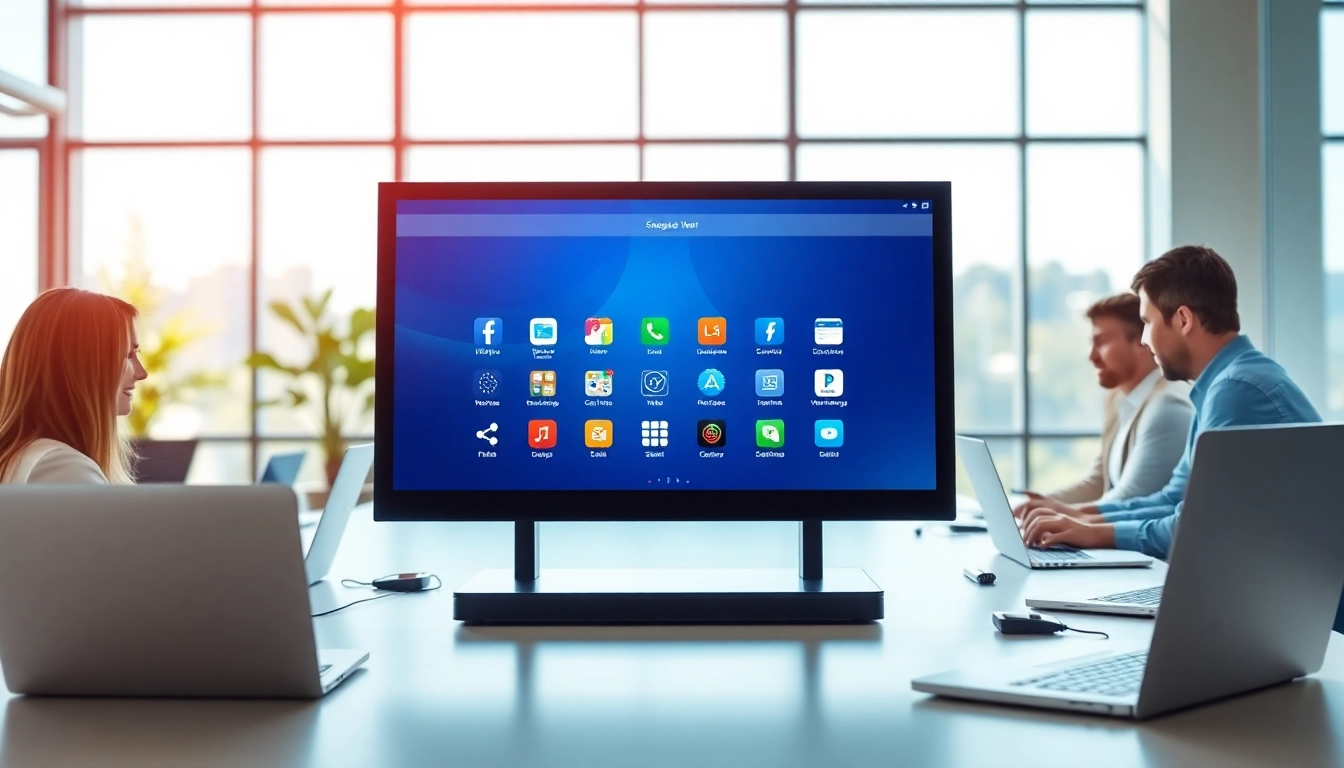Understanding the Android Digital Signage Player
What is an Android Digital Signage Player?
An Android digital signage player is a device that utilizes the Android operating system to manage and display content on digital screens. These players are designed to facilitate the operation of digital signage networks in a variety of environments, from retail stores to corporate settings. The player acts as a bridge between the content management system (CMS) and the display hardware, ensuring that visual content is presented in a dynamic, engaging manner. By leveraging Android’s flexibility and application ecosystem, businesses can easily customize their signage solutions to fit specific needs.
Key Features of Android Digital Signage Players
Android digital signage players come equipped with numerous features that enhance their utility and effectiveness. Key features include:
- User-Friendly Interface: The intuitive interface makes setup and management accessible for users of all skill levels.
- Content Compatibility: They support a wide array of media formats, including images, videos, and text, enabling rich multimedia presentations.
- Remote Management: Many Android players allow for remote control and updates, which streamline management over large networks.
- Robust Connectivity Options: They typically offer multiple connectivity choices, including Wi-Fi, Ethernet, and Bluetooth, ensuring seamless integration into existing networks.
- Scalability: As companies grow, their digital signage needs do too; Android players can easily scale up to accommodate additional displays.
- Third-Party App Integration: These devices enable integration with various third-party applications for analytics, customer interaction, and social media engagement.
Benefits for Business Applications
The implementation of an Android digital signage player brings numerous benefits to businesses across various sectors:
- Enhanced Customer Engagement: Dynamic content delivery captivates audiences, leading to increased interest and interaction with displayed information.
- Cost-Effectiveness: Compared to traditional signage, digital systems reduce printing and maintenance costs significantly while allowing for easy updates and changes.
- Improved Communication: Digital signage facilitates real-time communication across multiple locations and channels, ensuring consistent messaging.
- Streamlined Operations: By automating content delivery and management, businesses can focus more on strategic activities rather than manual changes.
- Marketing Flexibility: Businesses can adapt their marketing strategies quickly in response to changing consumer behavior or external factors.
Choosing the Right Android Digital Signage Player
Factors to Consider When Selecting
When selecting an Android digital signage player, several critical factors should be taken into account:
- Performance Specifications: Look for players with sufficient processing power, memory, and storage to handle your desired content types and player demands.
- Display Compatibility: Ensure that the player can support the required resolution and formats of your existing displays.
- Software Support: Verify compatibility with your chosen CMS as well as any integration with additional marketing tools.
- Durability and Reliability: Consider the operating environment of the signage; players meant for outdoor use should have better weather resistance and cooling capabilities.
- Warranty and Support: Check the manufacturer’s warranty and customer support services to ensure timely assistance when needed.
Popular Use Cases Across Industries
Android digital signage players are versatile and can be employed in numerous scenarios, including:
- Retail Displays: Showcasing products, sales promotions, and advertisements in store windows or on the sales floor.
- Corporate Communications: Conveying company news, employee recognition, or important notices in office lobbies and break rooms.
- Transportation Hubs: Providing real-time information and wayfinding at airports, bus stations, and train terminals.
- Educational Institutions: Displaying announcements, event information, and educational content in schools and universities.
- Healthcare Facilities: Sharing patient information, emergency updates, and health messages in hospitals and clinics.
Comparing Specifications and Capabilities
When choosing the right Android digital signage player, it is crucial to compare the specifications and capabilities of different models. Here are some specifications to compare:
- Processor Type: A more powerful processor offers better handling of graphics and multitasking capabilities.
- RAM and Storage: Higher RAM and storage capacities allow for smoother operation and the ability to store more content.
- Output Resolution: Ensure the player can handle the resolution of your digital displays, such as 4K versus standard HD.
- Operating Temperature Range: For outdoor or harsh environments, ensure the player operates reliably under varied temperature conditions.
- Multizone Capability: Ability to run different content in various sections of the screen for more extensive presentations.
Setup and Installation Process
Step-by-Step Installation Guide
Setting up an Android digital signage player involves several essential steps:
- Unbox the Device: Carefully unpack the player and all included components, ensuring nothing is missing.
- Connect to Display: Use the provided HDMI or other output cables to connect the player to the display.
- Set Up Power: Plug the device into the power source and turn it on.
- Network Configuration: Connect the player to your network—either through Wi-Fi or Ethernet. Configure the settings accordingly.
- Install Necessary Apps: Access the Google Play Store to download any required applications for digital signage management.
- Upload Content: Use your CMS to create and upload content to the player.
- Test Functionality: Verify that the player displays content correctly and make necessary adjustments before full deployment.
Common Setup Pitfalls to Avoid
During installation, avoiding common pitfalls can save time and resources:
- Insufficient Network Bandwidth: Ensure your network can handle the data load without interruptions.
- Ignoring Compatibility: Always check that the player is compatible with your existing systems and displays.
- Neglecting Content Testing: Always test your content on the actual display before going live to avoid embarrassing errors.
- Poor Placement: Choose strategic locations for displays to maximize visibility and audience engagement.
Integrating with Existing Systems
Integrating an Android digital signage player with existing systems can enhance functionality and efficiency. Consider the following approaches:
- API Integration: Leverage APIs from your CMS to create seamless interaction between your software and the player.
- Centralized Management Tools: Use centralized software for all your digital signage to streamline updates and content management across multiple devices.
- Custom Applications: Create specialized applications to enhance service delivery, such as coordinating with CRM systems for targeted advertising.
- Monitoring Software: Utilize monitoring tools to track performance, ensuring optimal uptime and content delivery.
Content Creation and Management
Designing Engaging Content for Your Audience
Content is the cornerstone of effective digital signage. Here are strategies for creating engaging visual narratives:
- Know Your Audience: Tailor content to meet the specific preferences and behavior of your target demographic.
- Maintain Visual Consistency: Use consistent branding elements such as colors, fonts, and logos to reinforce brand identity.
- Leverage Storytelling: Craft stories that encourage emotional connections and engagement, rather than mere data delivery.
- Utilize High-Quality Media: Incorporate high-resolution images and videos, as quality influences perception and engagement.
Best Practices for Content Scheduling and Rotation
Effectively managing content scheduling is key to maximizing impact:
- Content Calendar: Create a content calendar that outlines when and what content will be displayed to ensure a cohesive messaging strategy.
- Diverse Content Types: Rotate between different content types, like promotions, testimonials, and informational updates, to keep the audience engaged.
- Timing Considerations: Use data on audience behavior to determine optimal display times and adjust content accordingly.
- Emergency Notifications: Keep a system for emergencies that allows for immediate content overrides to relay urgent information.
Utilizing Software Solutions for Management
Using robust software solutions to manage digital signage content enhances efficiency:
- Cloud-based Management Systems: These allow for easy access and updates from any location, simplifying the operational process.
- Analytics Tools: Utilize analytics to track viewer engagement and adjust content strategies based on performance data.
- Template Use: Leverage pre-designed templates for quick content creation without sacrificing quality.
- User Roles and Permissions: Establish clear roles within the management system to streamline operations and maintain content integrity.
Measuring Performance and Effectiveness
Metrics to Track Engagement and Impact
To assess the effectiveness of your Android digital signage, monitoring the right metrics is important:
- Viewership Analytics: Use tools to track how many viewers engage with your content and for how long.
- Click-through Rates (CTR): Measure interactions with displayed calls to action or promotional links.
- Content Effectiveness: Compare the performance of various content types to determine which resonates best with your audience.
- ROI Calculations: Evaluate the financial returns against investments made in digital signage to judge overall effectiveness.
Adjusting Strategies Based on Analytics
Data-driven decision-making is key to optimizing digital signage effectiveness:
- Trend Analysis: Regularly analyze engagement data to identify trends or shifts in audience preferences.
- Experimentation: Use A/B testing methods to experiment with different content layouts or types to find the most impactful combinations.
- Feedback Loops: Solicit feedback from staff and customers to enhance content and address gaps.
- Competitor Comparisons: Monitor similar businesses, learning from their successes and challenges in digital signage.
Real-World Success Stories and Case Studies
Case studies offer valuable insights into how businesses are successfully leveraging Android digital signage:
- Retail Chains: Many retail chains have reported increases in sales due to strategically placed digital signage that highlights promotions.
- Educational Institutions: Schools using digital signage for announcements have experienced improved communication and student engagement.
- Healthcare Facilities: Hospitals utilizing digital signage for patient information have noted enhanced patient satisfaction through clear communication.
- Transportation Hubs: Airports deploying digital signage have seen significant improvements in passenger flow and information dissemination.



